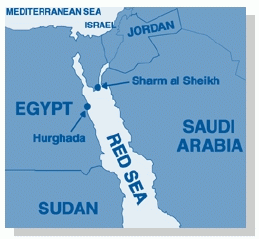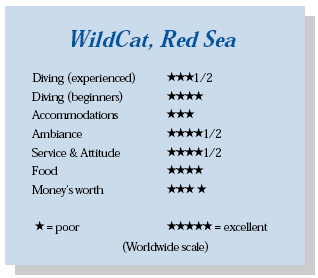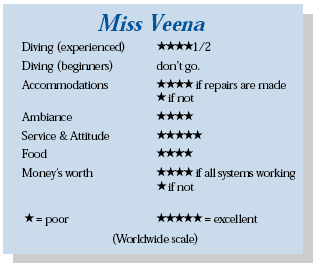The Red Sea, North and SouthContents of this Issue: Made a deposit then stayed home? The travel agent/wholesaler link Arm Wrestling, Whalesharks, Ghostly Visions Heart and Mind: New studies on diver safety Editorial Office: Ben Davison Publisher and Editor Undercurrent 3020 Bridgeway, Suite 102 Sausalito, CA 94965 for big fish action, avoid the day boats from the February, 2001 issue of Undercurrent
Dear Fellow Diver: A sea of red? Theories abound about the ultimate derivation of the name “Red Sea,” but one thing is for sure -- it’s a staggering cobalt blue. Located between Asia and Africa, it stretches from the Sinai Peninsula more than 1,000 miles south to the Indian Ocean. With a plethora of wrecks, invertebrates, coral, and more species of fish than any other proportional body of water, it’s a veritable Mecca for divers. Not surprisingly, live-aboards give you the best diving. They depart from both Sharm al Sheikh and Hurghada, about 90 miles southwest. With air temps ranging from the 60s in January and February to 100 degrees in July and August, and water from the low 60s in mid-winter to the mid-80s in mid-summer, spring and fall are the nicest times for travel. In October, two Undercurrent reviewers visited the Red Sea, one departing from Sharm and staying in the general area, the other departing from Hurghada and heading south. As you’ll see, there is a difference in the diving, indeed . * * * * Sharm is a working-class area; luxury hotels are in Na’ama Bay about four miles to the north. While peachy for tourism, this burgeoning development does not bode well for diving, not only in terms of run off and pollution, but also in terms of diver and snorkeler pressure. You see, Sharm is home to hundreds of day boats and about 20 liveaboards, catering especially to Europeans. When we dived around Sharm and the national park, Ras Mohammed, it was not unusual for 10-20 other dayboats to be on a site. I saw snorkelers dropped on reef tops, where they kicked and even intentionally broke off pieces of coral. A diver in our group fell victim to such frenzied activity when she was struck by the propeller of a neighboring boat’s Zodiac. She sustained scalp and shoulder lacerations as she hung just below the surface. The head wound may have been fatal had it been just a half-inch deeper. As it was, she spent the night in a Sharm hospital, rejoining us the following day in good health and spirits. Her diving, however, was over for the trip. The main deck salon features handsome wood, and sports a sound system, VCR, TV and a video/book library. They seldom used the A/C, so daytime temps below deck made it uncomfortable for me to occupy my cabin. They often ran it for a while at night, cooling the rooms enough to sleep. If applied as sparingly in the extreme heat of mid-summer, I would not be a happy cruiser. Small water capacity necessitated returning to port during the week for a refill, a two-plus hour process amid scores of boats belching fumes. Don’t drink the water; several who tried paid the price (stick with the free bottled water, soda and fruit juice; Egyptian beer and limited spirits can be purchased or byob). A small camera table in the rear and no respected dedicated rinse tank annoyed camera buffs. The crew, headed by Connie, a diminutive Filipina with a cheery disposition,
carried out their responsibilities diligently. Connie is a whirling-dervish neat
freak who kept the vessel tidy despite our slovenly, live-aboard decorum. The regular divemaster, a Slovenian woman, was absent due to an arm injury, so the laconic and long suffering Hesham served in her stead. Long suffering because he desperately wanted us to buddy and stay in a group, but the more experienced simply smiled and said “Okay,” and then went off on their own. A good sport, he tended to the divers who wanted a guide. He gave excellent briefings, and endeavored to get us five dives a day but given our general reluctance to rise at 5:00 a.m., four seemed the norm. I did 27, many lasting an hour or more. The Zodiac driver had an uncanny sense of where to pick up our widely disbursed group and the captain, a laconic old Red Sea vet, clearly knew his stuff.
As for the diving, it was water hovering around 80, vis 60-100 + feet, and it was just plain nice to be in the water. We did the standard northern itinerary, running northeast to Woodhouse Reef (between Na’ama and Sharm), northwest to the Thistlegorm Wreck (at the entrance of the Gulf of Suez) and south to the Shark Observatory (a short way off Ras Mohammed and well north of Hurghada). I found the reefs relatively uninteresting below 40 feet, but the top 20 feet at several sites was endlessly fascinating. They sported florid displays of luxurious leafy green coral open like verdant Bibb lettuce, and stands of pink and purple Klunzinger’s soft coral. Anthias spread as far as the eye could see. Sohal surgeonfish with their bright orange flash, flamboyant lionfish, and masked butterflyfish in lemon yellow with dove gray eye patches were prolific, as were small critters like tiny network pipefish. Then there were larger ones, such as the bodacious Napoleon wrasse and morays, reaching over eight feet and thick as a man’s calf. Feisty titan triggers provided comic relief from time to time (if you are not the target), launching sneak attacks on the gluteal regions of the unsuspecting, myself in particular. Of course, there were numerous leather, magnificent bulb anemones, each with it’s pugnacious resident, the two-bar anemonefish. I saw few pelagics; notably a couple of modest-sized gray reef sharks. My odd fish awards went to the Indian Flathead or crocodilefish, a member of the scorpionfish family, and a drab eel on a night dive. Rarely observed, their monochromatic pearlescent body with translucent fins is beautiful. To moor, the divemaster swims a line below and ties off on an underwater mooring or a wreck — and wrecks there are plenty! The Chrisoula K and the Tile Wreck can be well covered on the same tank. Many sections of the latter, which carried Italian tile when it went down, can be easily penetrated. Here I observed a mass of golden sweepers being pumped in and out of a hold by the surge, almost as if the pistons of the wreck still operated. The granddaddy of Red Sea wrecks, however, is the Thistlegorm, a 415-foot British WWII supply ship which carried massive amounts of military gear to forces in North Africa. Sunk in 1941 by German bombs, her bottom rests at 100 feet. The largely intact forward section sits almost upright, with the main deck at 45 feet. Dropping in above the bow, I was thrilled by her immensity, which was such that the train stock on the deck looked like large toys. Moving gradually toward the stern, I explored in awe various holds ripped open by massive explosions, and came upon Morris cars, Bedford trucks carrying BSA motorcycles, vehicle spares, aircraft parts, radios, rifles, rubber boots and ammunition. Had I been able to speak, I would have been wordless. We dove it several times -- I needed at least four dives just to do it justice. Make no mistake, this is one of the world’s premier recreational limits wreck dives. Despite very much enjoying this trip, given the distance, travel costs, and heavy diver aggregation at most sites, I would not do it again. I would, however, return to do a southern itinerary that, as you will read below, is just what my fellow correspondent did. -Doc V. Aboard Miss Veena in the Red SeaA half century ago famed songwriter Johnny Mercer advised: “ Ac-cent-tchu-ate the positive, e-li-my-nate the negative, Latch on to the affirmative...” I took those words as my mantra during my 14-day trip from Hurghada to the deep south of the Egyptian Red Sea on the new live-aboard Miss Veena. There were lots of positives to accentuate, but unfortunately more than a reasonable share of negatives to eliminate. Advertising and brochures establish expectations, of course, and that brand spankin’ new live-aboard Miss Veena was touted as the “Queen of the Red Sea” with a “new level of luxury and operational standards not often seen in Red Sea livea boards.” I was stoked in anticipation because my trip to that area years back had been wondrous and Egyptian authorities had only recently opened it, after closing it to diving for three and a half years. To “accentuate the positive,” from the “checkout dives” only a short distance from Hurghada, I saw many highlights of these waters; a Spanish Dancer on the first night dive, dozens of lionfish, scorpion fish, burrowing gobies with their attendant shrimp, the endemic masked butterfly fish and the Arabian Angelfish with the unusual map of Africa on its side. We moved south to the fabled Brothers (Big and Little) Islands, among the best of the Red Sea. The current can be challenging, but that’s the very reason I could list in my log book, mantas, turtles, sharks, barracuda, and tuna, as well as schooling black snapper, jacks, coronetfish, crocodile fish, and shimmering anthias dancing above the soft corals. Not to mention the rainbow mantled Tridacna clams. After the Brothers came mystical Zagarbad, enchanting Daedulus, and the ripping currents of Rocky Island -- all places where I interacted with creatures large and small. Though sharks were not as prevalent as on past trips to the Red Sea, there were the occasional hammerhead, grey reefs and slender white tips. One lucky Austrian diver saw a thresher shark at a depth deeper than I had ventured. Several times I got up close and personal with mantas. There were turtles on many dives and giant and green morays were ubiquitous, often free-swimming, and lumbering Napoleon wrasses cruised among the divers, unafraid and aloof. While this is splendid fish watching, to me the glory of the Red Sea is in the magnificent colors of the corals and swirling small fish dancing in streaming sunlight. To hover and watch shimmering anthias over the orange, red and pink soft corals is to gaze again upon Chris Newbert’s photographic masterpieces in his “Rainbowed Sea” and “Sea of Dreams” books. There may be coral bleaching elsewhere in the world, but here the corals are healthy and brilliant. And there are unique critters like rare dragon sea moth and a white eel trying to avoid a camera lens in the Safaga area. A dusk dive at Mangrove Bay yielded turtles, blue spotted lagoon rays, streams of surgeon fish, a stargazer, and a colony of striped pipefish. We left the Marine Park and headed to St. John’s Reef, closer to the Sudan
border. On the other hand, I was not as thrilled with the Miss Veena, not exactly the “Queena the Red Sea.” She is cosmetically appealing -- a beautiful 34-meter modern wooden yacht with two powerful engines. There are nine cabins with en-suite toilet facilities for 18 guests; eight on the lower deck have double bed under, twin bed over. The cabin on the top deck has a queen bed. Cabins are comfortable, but badly designed. With the room available, there could be side by side twin beds instead of bunks, and storage space under the beds. A small refrigerator is useless and reading lamps are flimsy. The two forward cabins are less spacious. The bathrooms have a toilet, bidet-type hose, sink and shower. Toilet paper is put into the wastebasket and the shower is not enclosed. On a more serious note, a defect in the venting system allowed noxious sewage gases into several cabins and nothing helped alleviate the stink. A couple of cabins had serious water leaks through the ceiling soaking mattresses and bed clothes. The air conditioning in some cabins, particularly the one on the top deck, was problematic. The main deck has a small forward salon, the galley, the main salon with two tables seating nine each for meals, and a bar/entertainment area, with TV and CD player. Because of lack of space for cameras the forward salon with its TV/VCR, upholstered chairs and several small tables became the photographer’s room. In here was a small bar with cold beer and soft drinks for sale. The main dining salon is inadequately air conditioned when all guests are present. Opening the salon windows for the evening meal helped, but with the AC off the cabins below became hot. The dive deck, too small for a full boat, is crowded with benches, tanks and hanging wet suits. Tanks are clamped upright at the benches, with an insufficient number of plastic crates under the benches to hold all dive gear. No camera storage space and a plastic bucket was the only rinse tank. There is a bathroom with toilet, shower and washstand. Four stairs led (port and starboard) from the ‘dive deck’ to the fairly spacious swim platform and the three sturdy ladders at the stern. The space was sufficient only after the divemaster started sending divers in waves rather than all at once. However, the upper deck is roomy and partially covered with a canvas awning. Aft of the bridge are tables and long upholstered benches on both sides. They allow smoking here. Live-aboards in the Red Sea have, over the years, had a poor reputation for comestibles. I thought that Chef Hassan and his cheerful helper, Ali, provided excellent food. A hearty breakfast after the morning dive had eggs to order, oatmeal, crepes, salad, cheese and orange slices, orange juice and pita bread. Lunches included soups and items like chicken breast, breaded fish or fish in cream sauce au gratin, salads, rice or potatoes. Dinners after the night dive started with soup and a salad, a tahini spread, then usually beef (most guests wanted more chicken, veal or fish). Snacks were boxes of cookies available night and day. Early in the trip there were bananas, pears, apples and grapes available in boxes in the main salon. Coffee and tea were always on the sideboard, and one guest from New Mexico, a coffee gourmet, provided some rare and tasty blends to fellow divers . My biggest quarrel was the failure to provide the promised large inflatables with 75 HP motors. What we got were two small, well-used inflatables with 25 HP motors. They were slow and necessitated running shifts to the dive sites. On the fourth day one motor blew and was never repaired, so we conducted most of the rest of the diving from the moored main boat, which eliminated some better dive sites. I also was chagrined to find that the promised Nitrox was unavailable due to blender problems. And despite the $2 billion in foreign aid each year, the boat Captain or Engineer seemed to express dissatisfaction with American foreign policy by dumping the sewage tanks as divers were doing safety stops under the boat. Outraged complaints resulted only in vague references to “an automatic dumping switch” and equally vague promises that “it won’t happen again.” It did happen again and again, and was more than annoying. Nevertheless, I commend the crew working the boat. Divemaster Johnny Goggel, though too glib for my taste, did an outstanding job given the unhappiness with the crowded dive deck, the unavailability of Nitrox, and the loss of the inflatable. He consulted with Captain Nagy to find the best sites considering the weather and gave informative briefings, especially helpful to photographers. His Assistant, Mahmed Mady, a true Prince of Egypt, was always anxious to help, guide, play chess or just tell tales of his country. Deck crew Sayed and Mohammeds One and Two were cheerful and helpful. So, if I “accentuate the positive”; “eliminate the negative” and “latch on to the affirmative,” Miss Veena would be an acceptable craft if they fix the myriad problems. Having been on dozens of live-aboards, I rolled with the punches. Some divers did not. The brochure states that “Miss Veena ... is specifically designed for divers looking for luxury.” Those guests who took that claim seriously were not happy . - J.S. |

I want to get all the stories! Tell me how I can become an Undercurrent Online Member and get online access to all the articles of Undercurrent as well as thousands of first hand reports on dive operations world-wide
| Home | Online Members Area | My Account |
Login
|
Join
|
| Travel Index |
Dive Resort & Liveaboard Reviews
|
Featured Reports
|
Recent
Issues
|
Back Issues
|
|
Dive Gear
Index
|
Health/Safety Index
|
Environment & Misc.
Index
|
Seasonal Planner
|
Blogs
|
Free Articles
|
Book Picks
|
News
|
|
Special Offers
|
RSS
|
FAQ
|
About Us
|
Contact Us
|
Links
|
3020 Bridgeway, Ste 102, Sausalito, Ca 94965
All rights reserved.

 We were aboard the Wild Cat, an 87-footer
only a couple of years old, that could meet
USCG standards with its navigational goodies.
A remarkably quiet craft, she takes 14 divers,
but the 12 in a group I helped organize filled
the dive deck, Zodiac and other available
space. Five twin modest-sized staterooms, with
little storage space, have en-suite marine
toilets (a sign reads, “Nothing goes into this
toilet unless you’ve eaten it first”) and
showers in a single cabin, so remove towels
and toilet paper before showering. A handsome
VIP master suite has a queen-sized bed, bath,
shower, color television, VCR and mini-bar. I
took the small crew room alone. Its sole
amenity, a sink, served a number of useful
purposes, and I showered on the dive deck,
which has two hot water hoses and relative privacy
after the last night dive.
We were aboard the Wild Cat, an 87-footer
only a couple of years old, that could meet
USCG standards with its navigational goodies.
A remarkably quiet craft, she takes 14 divers,
but the 12 in a group I helped organize filled
the dive deck, Zodiac and other available
space. Five twin modest-sized staterooms, with
little storage space, have en-suite marine
toilets (a sign reads, “Nothing goes into this
toilet unless you’ve eaten it first”) and
showers in a single cabin, so remove towels
and toilet paper before showering. A handsome
VIP master suite has a queen-sized bed, bath,
shower, color television, VCR and mini-bar. I
took the small crew room alone. Its sole
amenity, a sink, served a number of useful
purposes, and I showered on the dive deck,
which has two hot water hoses and relative privacy
after the last night dive. Bathrooms
were cleaned and beds were changed daily; although towels ran short toward the end
of the week. Working in a galley the size of a broom closet that reached temperatures
approaching those of the sun’s surface,
Chef Abraham turned out copious
amounts of food. For breakfast he prepared
eggs made to order, pancakes as
light as any I’ve tasted, fruit plates,
toast, cereal and juice. Lunch and dinner
consisted of chicken, fresh fish, pork
and beef, often with a light curry sauce.
Between-dive snacks might be mini-pizzas,
cookies, brownies or cake. The man even
produced apple pies with homemade crust
and a birthday cake.
Bathrooms
were cleaned and beds were changed daily; although towels ran short toward the end
of the week. Working in a galley the size of a broom closet that reached temperatures
approaching those of the sun’s surface,
Chef Abraham turned out copious
amounts of food. For breakfast he prepared
eggs made to order, pancakes as
light as any I’ve tasted, fruit plates,
toast, cereal and juice. Lunch and dinner
consisted of chicken, fresh fish, pork
and beef, often with a light curry sauce.
Between-dive snacks might be mini-pizzas,
cookies, brownies or cake. The man even
produced apple pies with homemade crust
and a birthday cake. On one memorable dive I witnessed a school of snapper fleeing a cave like
bats at sunset and swam with a swirling
school of barracuda. At “The Maze” my
companion, Assistant Divemaster Mahmed
led me through a complexity of walls
and swim-throughs with dancing fish all
around. So, accentuating the positive,
I came home thrilled again with the
wonders of the Red Sea and its fish,
corals, invertebrates and the cheerful
hospitality of the Egyptians.
On one memorable dive I witnessed a school of snapper fleeing a cave like
bats at sunset and swam with a swirling
school of barracuda. At “The Maze” my
companion, Assistant Divemaster Mahmed
led me through a complexity of walls
and swim-throughs with dancing fish all
around. So, accentuating the positive,
I came home thrilled again with the
wonders of the Red Sea and its fish,
corals, invertebrates and the cheerful
hospitality of the Egyptians. Diver’s Compass: WILDCAT:
Diver’s Compass: WILDCAT: 